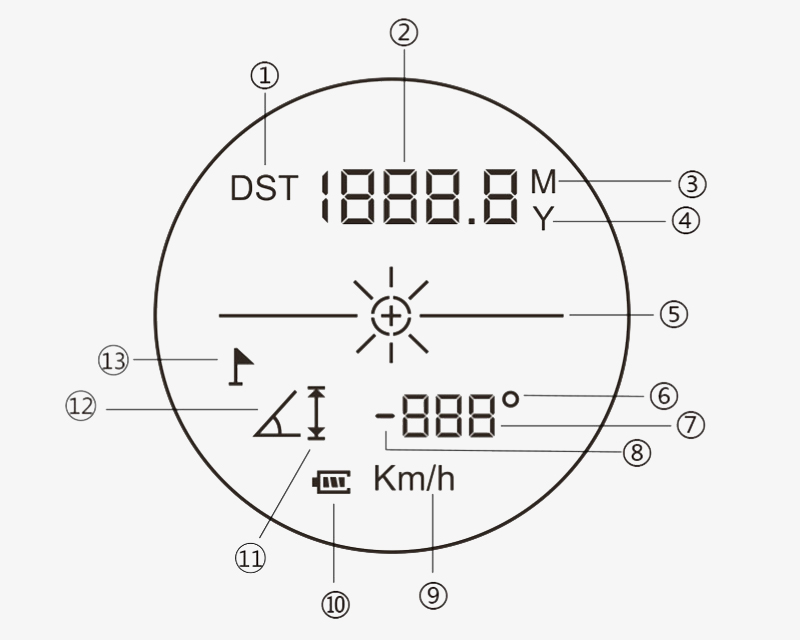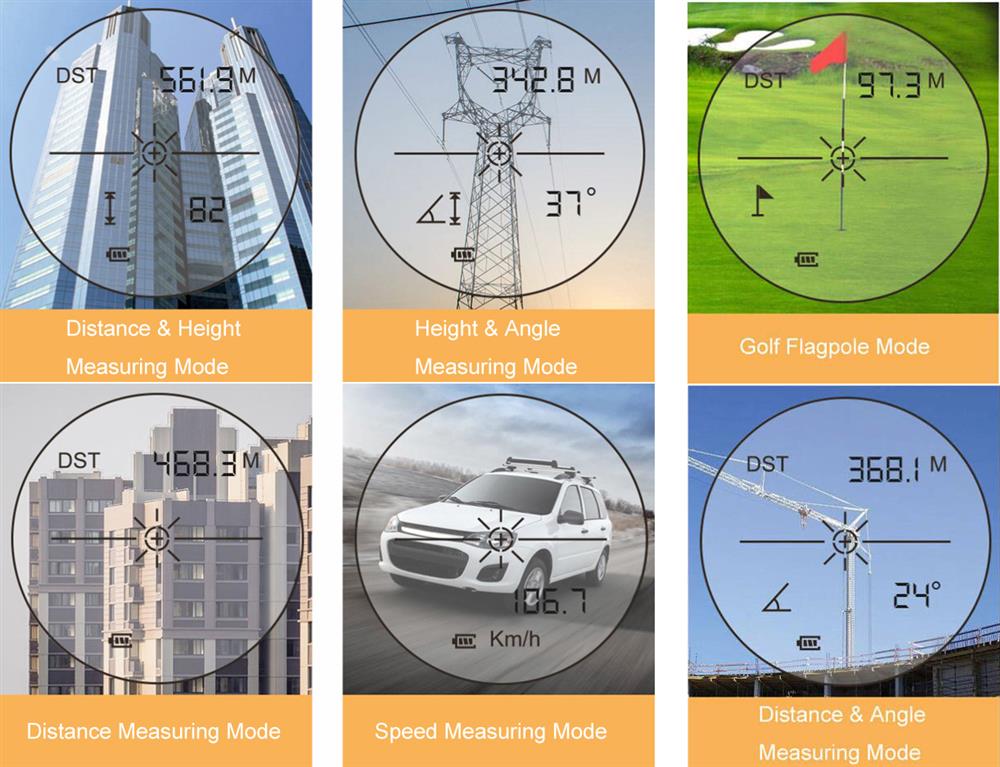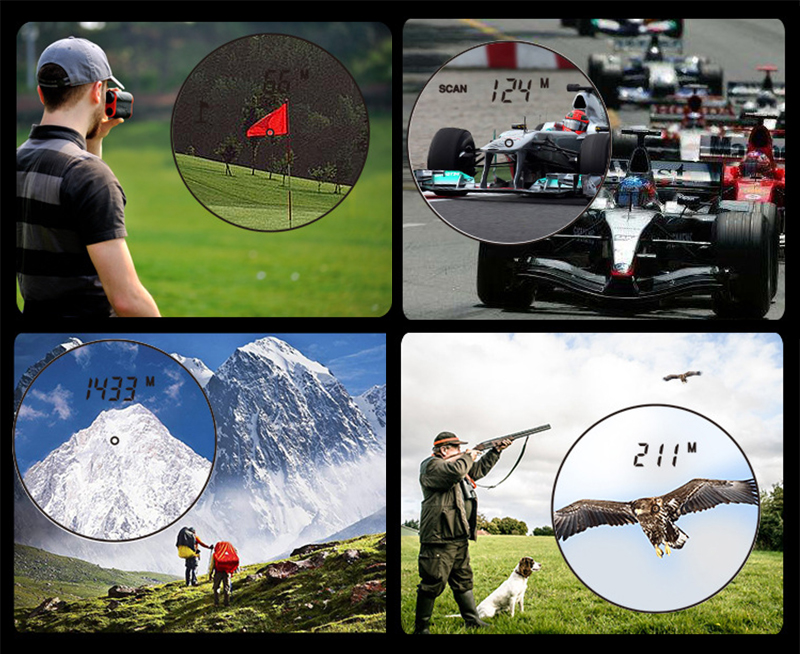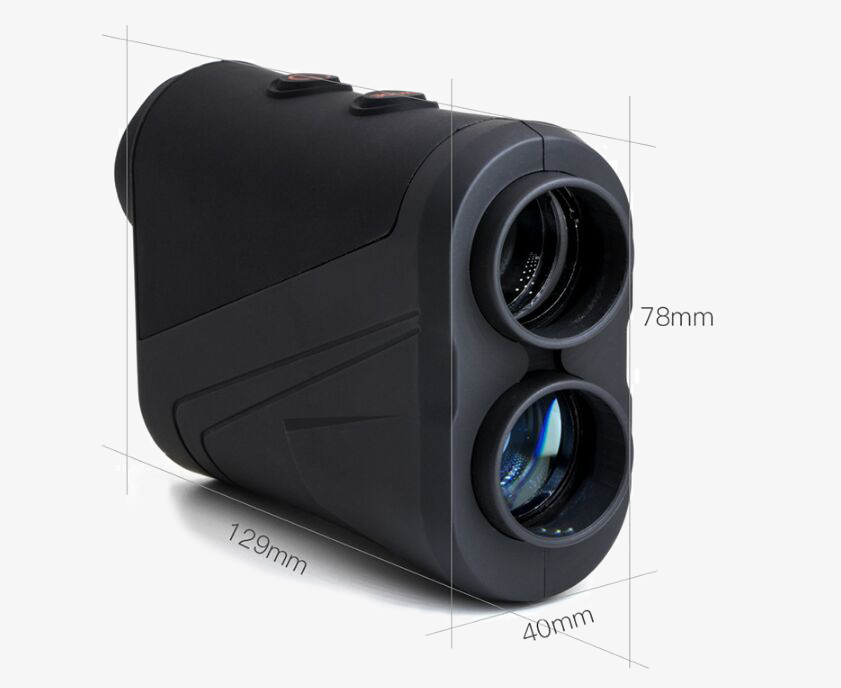Laser golf rangefinder with +/- 0.3 yds high ranging accuracy for sales, delivers range distances up to 1600 yds. SISCO laser rangefinder can meet most users’ needs. Fully multi-coated optics lenses effectively reduce reflected light and increase the transmission of light giving you a brighter clear image. It is a rangefinder tool that can meet various measurement needs and can measure distance, height and angle.

LCD liquid crystal display design
- Sign of distance measuring mode
- Measurement value (display in the modes of distance measuring and speed measuring)
- Distance measurement unit (m)
- Distance measurement unit (m)
- Sign of laser emission aimed at the target
- Angle measurement unit (degree)
- The measurement value of height/angle
- Minus sign (When measuring angles, "-" indicates the pitch angle, while measuring heights, it indicates the level below the measured level)
- Speed measurement unit (km/h)
- Battery sign
- Height measuring mode
- Angle measuring mode
- Golf flagpole mode

Two-button operation design
- Easy to learn
- There are only two function buttons on the body, which is easy to operate.
Rangefinder 6 Measuring Modes

Application
Laser rangefinders are widely used in topographical surveys, battlefield surveys, tanks, aircraft, ships and artillery to measure the distance of targets, and to measure the height of clouds, aircraft, missiles and artificial satellites. LRF is an important technical equipment to improve the accuracy of high tanks, aircraft, ships and artillery. Due to the continuous reduction in the price of laser range finders, laser range finders have gradually begun to be used in industry, which can be widely used in industrial measurement and control, mines, ports and other fields.

| Model | SISCO-CS1600 |
| Ranging Method | Laser pluse |
| Distance Measuring Range | 1600 Yards |
| Ranging Accuracy | ± 0.3 Yards |
| Speed Detection Error | ± 5km/h |
| Angle Measuring Range | <±90° |
| Angle Measuring Accuracy | <0.3° |
| Magnification | 6X |
| Laser Safety Level | IEC60825-1 |
| 6 Measuring Modes | 1. Distance measuring mode 2. Speed measuring mode 3. Golf flagpole mode 4. Distance & Angle measuring mode 5. Distance & Height measuring mode 6. Height & Angle measuring mode |
| Objiective Caliber | 24mm |
| Eyepiece Caliber | 16mm |
| Focus Way | Eyepiece Focus |
| Display | LCD |
| Operating Temperature | 0℃-40℃ |
| Battery Model | CR2-3V (Rechargeable) |
| Size | 129*40*78 mm |
| Weight | 0.2kg (including battery) |
Dimension Unit (mm)

Q1: How does a laser rangefinder work?
A1: The Laser Rangefinder uses a laser beam aimed at the target to determine its distance. A laser is beamed to the target, like the pin, and reflects back to the rangefinder. The time in which it took the laser to reflect back to the device is used to calculate the distance.
Q2: What is a laser rangefinder?
A2: LRF or a Laser Range Finder is a device used to measure distances. Most laser rangefinders operate on the time of flight principle by sending a laser pulse in a narrow beam towards the object and measuring the time taken by the pulse to be reflected off the target and returned to the sender.
Q3: What is the range of a laser rangefinder?
A3: Laser rangefinders let you take measurements both indoors and outdoors with 1 mm per kilometre accuracy. Professional construction laser rangefinders can measure distance of up to approximately 150 metres. Long-range rangefinders can measure distance of up to 1500 metres.
Tips: Laser rangefinder troubleshooting
The laser rangefinder cannot turn on:
- Make sure the batteries are inserted in the correct orientation and that the battery compartment cover is securely screwed in.
- Check the label inside the battery compartment for the proper orientation of the battery.
- There should be no gap between the battery compartment cover and the main unit.
- Verify the contact on the battery cover is still attached.
The laser rangefinder is difficult to measure:
- Focus on the target mark (crosshair) displayed in the field of view when the power is turned on.
- If the eyepiece is dirty, clean it.
- Adjust focus by turning the diopter adjustment ring. The diopter adjustment ring may be difficult or tight to turn, this is normal.
- Use a soft, dry cloth such as a microfiber cloth for cleaning glasses to clean the lens.
- If the dirt cannot be removed, use a soft cloth moistened with a cleaner. For measurement, hold it with both hands or lightly lean against a tree, wall or golf cart to prevent shake.
Thank you for buying industrial test and measurement equipment on SISCO.com, all products sold by SISCO and the partner cover a 12 months warranty, effective from the date of receiving the products.
What is covered?
SISCO is responsible for providing free spare parts, and free technical support to assist the customer to repair the defective products until the problem is solved.
What is not covered?
- Product purchased from anyone other than a SISCO store or a SISCO authorized reseller.
- Expendable parts.
- Routine cleaning or normal cosmetic and mechanical wear.
- Damage from misuse, abuse or neglect.
- Damage from use of parts other than SISCO approved.
- Damage from use outside the product’s usage or storage parameters.
- Damage from use of parts not sold by SISCO.
- Damage from modification or incorporation into other products.
- Damage from repair or replacement of warranted parts by a service provider other than a SISCO authorized service provider.
- Damage caused by the application environment not meeting the product usage requirements and the failure to perform preventive maintenance.

